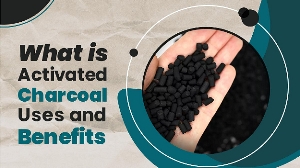In the recent surges of allegations of poisoning, everyone must take precautions. Besides, there are naturopathic ways to deal with poisoning that have been proven in studies. One such naturopathic remedy is activated charcoal.
Activated charcoal differs from the charcoal you buy from the charcoal seller or what you use to cook your meals. Though they may be made from the same base materials, the charcoal we used for cooking and at the barbeque hasn’t been activated at high temperatures. Additionally, they contain additional substances that are toxic to humans.
Activated charcoal is a black, odorless, flavorless powder that has been used since ancient times to treat various ailments. In recent times, it’s mostly utilized in medical settings to treat drug overdoses or as an emergency anti-poison remedy.
Some studies(Michele J. Sadler, 2018; Juurlink DN, 2016) found that activated charcoal used oxygen at very high temperatures to make it more porous. Due to this, it changes its internal structure, reducing the size of its pores and increasing its surface area.
The resulting fine black powder is either sold as is or encapsulated as supplements. Activated charcoal is added to various food and nonfood products, from ice cream to toothpaste.
In this article, I examine the science behind activated charcoal on our health.
Activated charcoal, science
Mechanism of action
Taylor et al. (2023) study found that due to the use of gas at high temperatures, causes it to develop microscopic holes, which increase its surface area. Activated charcoal doesn’t get absorbed by your gut. Thus, after you swallow it, it reaches your gut unchanged.
One retrospective review by Villarreal et al.(2015) found that the porous nature of charcoal has a negative electrical charge, which causes it to attract positively charged molecules, such as toxins and gases. When liquids or gases pass through this activated charcoal, they bind to it through a process known as adsorption.
In the body, absorption is the reaction of elements, including nutrients, chemicals, and toxins, soaked up and assimilated into the bloodstream. Adsorption is the chemical reaction where elements bind to a surface.
The review further found that these toxins and chemicals get trapped in your gut and eliminated through stool instead of being absorbed into your body. Activated charcoal is also very effective at adsorbing gases, which can help reduce flatulence.
Emergency poison treatment
Since ancient times, activated charcoal has been used as an emergency anti-poison treatment. It is used to remove toxins and chemicals in the event of ingestion. Most organic compounds, pesticides, mercury, fertilizer, and bleach bind to activated charcoal’s surface, allowing for quicker elimination, while preventing their absorption in the body.
This has been attributed to the fact that it can bind to a wide variety of drugs, reducing their effects (Juurlink DN, 2016; Alkhatib, & Al Zailaey, 2015). A recent study(Silberman et al. 2023) also found that activated charcoal is employed to treat overdoses from both prescription drugs and over-the-counter medications like aspirin, acetaminophen, and sedatives.
Others((Juurlink DN, 2016; Alkhatib, & Silberman et al. 2023) also found that taking 50–100 grams of activated charcoal within 5 minutes of taking a drug could decrease an adult’s ability to absorb that drug by up to 74%.
A recent review by Silberman et al. (2023) found that activated charcoal should be taken within the first hour after an overdose or poisoning as it is more effective. After this period, it is ineffective.
Other reviews(Hoegberg et al, 2021; Skov et al. 2021)found some instances where activated charcoal was effective even after the first hour. This is due to the reason that activated charcoal not only stops a drug from being absorbed but also helps your body eliminate already absorbed drugs more quickly.
Silberman et al. (2023) review explains that other studies found activated charcoal to be effective up to 4 hours after ingestion of delayed-release drugs, those which slow digestion, and large drug doses.
The same review found that the initial dose of 50–100 grams is sometimes followed by several smaller doses of 10–25 grams, taken every 2–4 hours for up to 6 hours in the medical sector.
Others(Zellner et al. 2019; Silberman et al. 2023) also found that the multiple-dose activated charcoal (MDAC) protocol could fight intoxications from slowly absorbed drugs.
The researchers also found that MDAC could help in life-threatening ingestion of dapsone, phenobarbital, quinine, carbamazepine, and theophylline.
This notwithstanding(Zellner et al. 2019; Villarreal et al. 2015; Juurlink DN, 2016) also found that activated charcoal is not effective in all cases of poisoning such as on alcohol, heavy metal, iron, lithium, potassium, acid, or alkali poisonings.
An older study by Hultén BA(1986) found that when activated charcoal is taken at the same time as alcohol, it can significantly reduce blood alcohol concentrations.
Princeton University’s First Aider’s Guide to Alcohol(2024) found that activated charcoal is administered in some situations related to alcohol. This includes if the individual is unconscious or showing signs of acute alcohol poisoning.
Hence, it is not every case of poisoning warrants activated charcoal usage(Chyka et al. 2005; Silberman et al. 2023; Chyka et al. 2005).
A recent study by Al Jumaan MA(2023) found that it is an antidote in the event of an accidental, or purposeful, overdose of many pharmaceutical drugs and over-the-counter medications. It’s effective for aspirin, opium, cocaine, morphine, and acetaminophen overdose.
Promote kidney function
One study(Ali et al. 2014) found that activated charcoal could promote kidney function by decreasing the number of waste products that the kidneys filter.
This could help people with chronic kidney disease. Healthy kidneys are normally very well equipped to filter your blood, but this condition inhibits your kidneys’ ability to remove urea and other toxins.
The same study found that activated charcoal could bind to urea and other toxins, to support the body in eliminating them.
A review(Skov et al. 2021) explains that urea and other waste products can pass from the bloodstream into the gut through a process known as diffusion. In the gut, they bind to activated charcoal and get excreted in stool.
Older human studies(Alkhatib & Al Zailaey, 2015; Musso et al. 2010; Schulman G. 2006) suggest that activated charcoal could help lower blood levels of urea and other waste products, as well as improve kidney function in people with chronic kidney disease(CKD).
One small randomized controlled study(Gao et al. 2019) in Chinese patients found the same results. In this study, 97 patients with stage 3-4 CKD were followed for 12 months. The study concluded that oral activated charcoal effectively delays the onset of hyperphosphatemia in patients with chronic kidney disease.
Hyperphosphatemia is a condition in which you have too much phosphate in your blood. It also appears to delay the development of vascular calcifications in stage 3-4 CKD patients.
A previous study(Vaziri et al. 2013) suggests that activated charcoal helps to prevent cellular damage to the kidneys and liver and supports healthy adrenal glands. This is done by removing toxins and chemicals routinely from the body.
Decrease symptoms of fish odor syndrome
Some studies have reported that activated charcoal could reduce unpleasant odors in those suffering from trimethylaminuria (TMAU), also known as fish odor syndrome.
TMAU is a genetic condition in which trimethylamine (TMA), a compound that smells like rotting fish, accumulates in your body.
For instance, (Phillips and Shephard, 2020) study reports that the body normally converts TMA into an odorless compound before excreting it through urine, but people with TMAU lack the enzyme needed to perform this conversion. This causes TMA to accumulate and enter urine sweat, and breath, causing a foul, fishy odor.
Because activated charcoal’s porous surface could bind to small, odorous compounds like TMA, thus increasing their excretion.
In one small, older study( Yamazaki et al. 2004) those with TMAU were given 1.5 grams of charcoal for 10 days. This dosage decreased TMA concentrations in their urine to normal levels.
Another case study(Girdwichai et al. 2015) found that taking activated charcoal with drugs and dietary changes could reduce fishy odor in people with TMAU.
Decrease cholesterol levels
Some studies support activated charcoal to decrease cholesterol levels. Older studies for instance( Krasopoulos et al. 1980; Tishler et al. 1987) found that activated charcoal could bind to cholesterol and cholesterol-containing bile acids in the gut, preventing them from being absorbed.
Another older study(Kuusisto et al. 1986) found that when one takes 24 grams of activated charcoal per day for 4 weeks, it decreases the total and LDL (bad) cholesterol by 25% and increases HDL (good) cholesterol by 8%.
Another older study(Neuvonen et al. 1989) also found that giving 4–32 grams of activated charcoal daily reduces total and LDL (bad) cholesterol by 29–41% in people with high cholesterol levels. Higher doses were most effective.
Other studies(Neuvonen et al. 1989; Glen et al. 1988; Hoekstra and Erkelens, 1989) also found the same conclusions, though the results are mixed. For instance, Glen et al. (1989) evaluate the relative abilities of superactivated charcoal (20 g twice daily) and cholestyramine (8 g twice daily) to lower plasma cholesterol concentrations acutely, six hyper-cholesterolemic patients were studied using a randomized cross-over design.
After a 1-week dietary control period, each subject received 3 weeks of each treatment regimen on separate occasions. Superactivated charcoal and cholestyramine reduced total plasma cholesterol by 21.8 ± 3.8% and 16.2 ± 2.4%, respectively. Side effects were mild and similar for both treatments.
At the dosage regimens studied, superactivated charcoal and cholestyramine have comparable ability to lower plasma cholesterol concentrations. The only challenge is that these studies are older.
Anti-aging
One study(Vaziri et al. 2013) suggests that activated charcoal helps to prevent cellular damage to the kidneys and liver and supports healthy adrenal glands. This is done by removing toxins and chemicals routinely from the body.
It supports major organs by helping the body flush out the toxins and chemicals that cause internal damage. For instance, one study by(Rafati-Rahimzadeh et al. 2014) found that it removes organic and inorganic compounds from the body, and tightly binds with metallic compounds.
Aging is a natural part of life, but due to the toxic load we are exposed to through food, our homes and workplaces, and our environment, to prevent premature aging we must get rid of them, and activated charcoal does it so well.
Mold Cleansing
Toxic mold can cause depression, kidney and liver failure, decreased brain function, heart disease, eye irritation, headaches, vomiting, impaired immune system function, and severe respiratory distress.
Homes that have flooded, or even those with small leaks under a sub-floor or in the walls, can create an environment where mold can thrive. Poor ventilation contributes to the problem, and bathrooms, basements, and laundry rooms are particularly prone to mold growth.
Using activated charcoal can help mitigate areas of mold overgrowth in your home. For instance(Hope J. 2013) review found that activated carbons, or charcoals, have effective binding capacity and can produce a significant reduction in mold absorption. Charcoal has also proved to be an effective agent for removing 90 percent of mold in a tested solution.
Be sure to keep a lookout for symptoms of mold exposure, like wheezing, rashes, watery eyes, coughing, or headaches, especially when they can’t be linked to other health issues. If you notice these signs, your home should be evaluated for mold spore levels, even if no visible mold is detected. It can thrive behind drywall, under floors, and in ventilation ducts, and you may not even realize the levels are high until you have testing done.
Other studies, limited science
1. Digestive Health- An old study(Naka et al. 2001) found that activated charcoal had lower binding capacity to the normal bacterial flora tested than that to E. coli O157:H7 strains.” It appears as though toxin-producing strains of E. coli were more likely to be adsorbed by the activated charcoal while normal bacterial flora in the intestine, including Enterococcus faecium, Bifidobacterium thermophilum, and Lactobacillus acidophilus, were more likely to be left alone.
One recent study(Jabar et al. 2020) found that taking activated charcoal 8 hours before an abdominal ultrasound significantly reduces the amount of gas in the gut, making it easier to get a clear ultrasound image.
A more recent study(Silberman et al. 2023) found that activated charcoal helps promote a healthy digestive tract by removing toxins that cause allergic reactions, oxidative damage, and poor immune system function. By removing the toxins from your system, you can reduce joint pain, increase energy, and increase mental function.
A previous case study(Senderovich and Vierhout, 2018) found that activated charcoal could treat diarrhea, but higher-quality studies are necessary.
2. Water filtration- Jaspal and Malviya(2020) study found that activated charcoal could filter water by removing contaminants, suspended solids, and microorganisms like bacteria — and not destroying the water’s pH or taste.
A previous study(Konno et al. 2008) found that activated carbon filters (activated charcoal), remove some fluoride. Avoiding fluoride and detoxing from it is important for oral health, proper immune system functioning, and healthy kidneys and liver.
Though, drinking water is essential to good health — however, typical tap water is toxic and laden with chemicals, toxins, and fluoride. It’s a good idea to limit ingestion whenever possible and use an activated charcoal water filter.
3. Tooth whitening- One review(Brooks et al. 2020) found that there is a science to support that activated charcoal whitened teeth. A recent study(Alofi et al. 2021) found that it works to whiten your teeth by absorbing plaque and microscopic tidbits that stain teeth.
According to research done by a professor of dentistry at King’s College London, “charcoal toothpaste may be found to help remove external (extrinsic) staining on teeth without negative abrasive effects.” She adds that toothpaste containing charcoal may be most effective when used to delay the recurrence of surface staining on intact teeth after professional cleaning and polishing.
4. Hangover prevention- Another study by (Silberman et al. 2023) found no science that activated charcoal supports hangover cure. Though activated charcoal does not adsorb alcohol, it does help quickly remove other toxins from the body that contribute to poisoning. When activated charcoal is taken at the same time as alcohol, some studies(Hultén et al. 1986) show it can significantly reduce blood alcohol concentrations.
5. Skin treatment. Though hearsay evidence says activated charcoal treats acne, dandruff, and insect or snake bites, no evidence supports these claims ( Sanchez et al. 2020).
This notwithstanding, another study(Hara et al. 2020) found that it is good for external treatments, it’s effective at treating body odor and acne, along with relieving discomfort from insect bites, rashes from poison ivy or poison oak, and snake bites.
An old study(Chakravarth et al. 2008) also found that when applied topically as an activated charcoal mask or mixed with other ingredients like aloe vera, it’s able to bind to poison, toxins, or dirt that contribute to skin issues or bite reactions.
It can also help reduce foul odors that are associated with blistering disorders and extensive skin loss. It can be used to reduce odor when combined with baking soda.
Safety
Activated charcoal is considered safe in most cases, and adverse reactions are infrequent. However, Silberman et al.(2023) study reports unpleasant side effects such as vomiting, especially if sorbitol is also used as an ingredient.
It has been linked to bowel blockages in some cases. Those with gut motility disorders, taking opioid or antimuscarinic medications, or taking MDAC- multiple-dose activated charcoal are at higher risk.
The American Academy of Clinical Toxicology (AACT) further warns against activated charcoal in cases of bleeding, blockage, or holes in your gut ( Silberman et al. 2023).
Moreover, when activated charcoal is used as an emergency poison antidote, there’s a risk that it can enter your lungs rather than your stomach. This is especially true if you vomit or are drowsy or semiconscious (Juurlink DN, 2016; Silberman et al. 2023; Zellner et al. 2019).
Hence, this substance should only be given to those who are fully conscious (( Juurlink DN, 2016; Silberman et al. 2023; Zellner et al. 2019).
Keep in mind that activated charcoal may also reduce the absorption of certain medications.
Dosage
Activated charcoal is available in a pill or powder form. If you opt for a powder supplement, mix it with water or juice to make it easier to swallow.
Make sure to follow the dosage instructions on the label, or use those in the studies mentioned above.
In the case of drug poisoning, seek medical help immediately. A medical professional may administer a dose of 50–100 grams of activated charcoal as soon as possible. Children are normally given a lower dose of 10–50 grams, depending on their age (Silberman et al. 2023).
Take notice that I used dosages for other conditions based on older studies; starting from 1.5 grams to treat fishy odor disease to 4–32 grams per day to lower cholesterol and promote kidney function in those with end-stage kidney disease (Musso et al. 2010; Schulman G. 2006; Kuusisto et al. 1986; Neuvonen et al. 1989).
I will update these recommendations as newer studies emerge.
Take Home
It’s most commonly used as an emergency overdose or anti-poison treatment. Significant amounts of research back this application.
It may also help lower cholesterol levels, fight symptoms of fishy odor syndrome, improve kidney function, and reduce gas and diarrhea.
Activated charcoal can interact with other medications, so check with your doctor before trying it if you’re currently taking medications. You may also want to start with the lower end of the recommended dose to see how you react to it before increasing the amount.
Activated charcoal is available in many forms, including pills, tablets, capsules, powder, toothpaste, and face masks.
It is safe to eat activated charcoal and to apply it topically, but make sure you are using a high-quality product that doesn’t contain any fillers or additives. Stick to short-term use, and consult your health care professional if you are taking medications that may interact with activated charcoal.
References
1. Michele J. Sadler (2018) 16 - Authorised EU health claims for activated charcoal, lactulose and melatonin. Foods, Nutrients and Food Ingredients with Authorised EU Health Claims. Pages 237-248
2. Juurlink DN. Activated charcoal for acute overdose: a reappraisal. Br J Clin Pharmacol. 2016 Mar;81(3):482-7. doi: 10.1111/bcp.12793. Epub 2015 Nov 9. PMID: 26409027; PMCID: PMC4767212.
3. Silberman J, Galuska MA, Taylor A. Activated Charcoal. [Updated 2023 Apr 26]. In: StatPearls [Internet]. Treasure Island (FL): StatPearls Publishing; 2024 Jan-. Available from: https://www.ncbi.nlm.nih.gov/books/NBK482294/
4. Villarreal J, Kahn CA, Dunford JV, Patel E, Clark RF. A retrospective review of the prehospital use of activated charcoal. Am J Emerg Med. 2015 Jan;33(1):56-9. doi: 10.1016/j.ajem.2014.10.019. Epub 2014 Oct 22. PMID: 25455049.
5. Alkhatib, A. J., & Al Zailaey, K. (2015). MEDICAL AND ENVIRONMENTAL APPLICATIONS OF ACTIVATED CHARCOAL: REVIEW ARTICLE. European Scientific Journal, ESJ, 11(3). Retrieved from https://eujournal.org/index.php/esj/article/view/4987
6. Hoegberg LCG, Shepherd G, Wood DM, Johnson J, Hoffman RS, Caravati EM, Chan WL, Smith SW, Olson KR, Gosselin S. Systematic review on the use of activated charcoal for gastrointestinal decontamination following acute oral overdose. Clin Toxicol (Phila). 2021 Dec;59(12):1196-1227. doi: 10.1080/15563650.2021.1961144. Epub 2021 Aug 23. PMID: 34424785.
7. Skov K, Graudal NA, Jürgens G. The effect of activated charcoal on drug exposure following intravenous administration: A meta-analysis. Basic Clin Pharmacol Toxicol. 2021 Apr;128(4):568-578. doi: 10.1111/bcpt.13553. Epub 2021 Jan 21. PMID: 33386684.
8.Chyka PA, Seger D, Krenzelok EP, Vale JA; American Academy of Clinical Toxicology; European Association of Poisons Centres and Clinical Toxicologists. Position paper: Single-dose activated charcoal. Clin Toxicol (Phila). 2005;43(2):61-87. doi: 10.1081/clt-200051867. PMID: 15822758.
9. Al Jumaan MA. The Role of Activated Charcoal in Prehospital Care. Med Arch. 2023 Feb;77(1):64-69. doi: 10.5455/medarh.2023.77.64-69. PMID: 36919135; PMCID: PMC10008342.
10. Hultén BA, Heath A, Mellstrand T, Hedner T. Does alcohol absorb to activated charcoal? Hum Toxicol. 1986 May;5(3):211-2. doi: 10.1177/096032718600500311. PMID: 3710499.
11. Ali BH, Alza'abi M, Ramkumar A, Al-Lawati I, Waly MI, Beegam S, Nemmar A, Brand S, Schupp N. The effect of activated charcoal on adenine-induced chronic renal failure in rats. Food Chem Toxicol. 2014 Mar;65:321-8. doi: 10.1016/j.fct.2013.12.038. Epub 2014 Jan 10. PMID: 24412558.
12. Musso CG, Michelangelo H, Reynaldi J, Martinez B, Vidal F, Quevedo M, Parot M, Waisman G, Algranati L. Combination of oral activated charcoal plus low protein diet as a new alternative for handling in the old end-stage renal disease patients. Saudi J Kidney Dis Transpl. 2010 Jan;21(1):102-4. PMID: 20061701.
13. Schulman G. A nexus of progression of chronic kidney disease: charcoal, tryptophan and profibrotic cytokines. Blood Purif. 2006;24(1):143-8. doi: 10.1159/000089451. PMID: 16361855
14. Gao Y, Wang G, Li Y, Lv C, Wang Z. Effects of oral activated charcoal on hyperphosphatemia and vascular calcification in Chinese patients with stage 3-4 chronic kidney disease. J Nephrol. 2019 Apr;32(2):265-272. doi: 10.1007/s40620-018-00571-1. Epub 2018 Dec 26. PMID: 30588573; PMCID: PMC6422957.
15. Phillips IR, Shephard EA. Primary Trimethylaminuria. 2007 Oct 8 [Updated 2020 Nov 5]. In: Adam MP, Feldman J, Mirzaa GM, et al., editors. GeneReviews® [Internet]. Seattle (WA): University of Washington, Seattle; 1993-2024. Available from: https://www.ncbi.nlm.nih.gov/books/NBK1103/
16. Yamazaki H, Fujieda M, Togashi M, Saito T, Preti G, Cashman JR, Kamataki T. Effects of the dietary supplements, activated charcoal and copper chlorophyllin, on urinary excretion of trimethylamine in Japanese trimethylaminuria patients. Life Sci. 2004 Apr 16;74(22):2739-47. doi: 10.1016/j.lfs.2003.10.022. PMID: 15043988.
17. Girdwichai N, Khemthong P, Tunteeratum A, Dejsuphong D, Eu-Ahsunthornwattana J, Sura T. AB134. Trimethylaminuria: report of two cases in Ramathibodi hospital. Ann Transl Med. 2015 Sep;3(Suppl 2):AB134. doi: 10.3978/j.issn.2305-5839.2015.AB134. PMCID: PMC4563423.
18. Krasopoulos JC, De Bari VA, Needle MA. The adsorption of bile salts on activated carbon. Lipids. 1980 May;15(5):365-70. doi: 10.1007/BF02533552. PMID: 7392829.
19. Tishler PV, Winston SH, Bell SM. Correlative studies of the hypocholesterolemic effect of a highly activated charcoal. Methods Find Exp Clin Pharmacol. 1987 Dec;9(12):799-806. PMID: 3441164.
20. Kuusisto P, Vapaatalo H, Manninen V, Huttunen JK, Neuvonen PJ. Effect of activated charcoal on hypercholesterolaemia. Lancet. 1986 Aug 16;2(8503):366-7. doi: 10.1016/s0140-6736(86)90054-1. PMID: 2874369.
21. Neuvonen PJ, Kuusisto P, Vapaatalo H, Manninen V. Activated charcoal in the treatment of hypercholesterolaemia: dose-response relationships and comparison with cholestyramine. Eur J Clin Pharmacol. 1989;37(3):225-30. doi: 10.1007/BF00679774. PMID: 2612535.
22. Vaziri ND, Yuan J, Khazaeli M, Masuda Y, Ichii H, Liu S. Oral activated charcoal adsorbent (AST-120) ameliorates chronic kidney disease-induced intestinal epithelial barrier disruption. Am J Nephrol. 2013;37(6):518-25. doi: 10.1159/000351171. Epub 2013 May 15. PMID: 23689670; PMCID: PMC3777856.
23. Rafati-Rahimzadeh M, Rafati-Rahimzadeh M, Kazemi S, Moghadamnia AA. Current approaches of the management of mercury poisoning: need of the hour. Daru. 2014 Jun 2;22(1):46. doi: 10.1186/2008-2231-22-46. PMID: 24888360; PMCID: PMC4055906.
24. Naka K, Watarai S, Tana, Inoue K, Kodama Y, Oguma K, Yasuda T, Kodama H. Adsorption effect of activated charcoal on enterohemorrhagic Escherichia coli. J Vet Med Sci. 2001 Mar;63(3):281-5. doi: 10.1292/jvms.63.281. PMID: 11307928.
25. Jabar AA, Abbas I, Mishah N, Wazan M, Tomehy M. Effect of adding a capsule with activated charcoal to abdominal ultrasound preparation on image quality. J Ultrason. 2020;20(80):e12-e17. doi: 10.15557/JoU.2020.0003. Epub 2020 Mar 31. PMID: 32320165; PMCID: PMC7266072.
26. Senderovich H, Vierhout MJ. Is there a role for charcoal in palliative diarrhea management? Curr Med Res Opin. 2018 Jul;34(7):1253-1259. doi: 10.1080/03007995.2017.1416345. Epub 2018 Jan 10. PMID: 29231746.
27. Jaspal D, Malviya A. Composites for wastewater purification: A review. Chemosphere. 2020 May;246:125788. doi: 10.1016/j.chemosphere.2019.125788. Epub 2019 Dec 30. PMID: 31918098.
28. Brooks JK, Bashirelahi N, Hsia RC, Reynolds MA. Charcoal-based mouthwashes: a literature review. Br Dent J. 2020 Feb;228(4):290-294. doi: 10.1038/s41415-020-1265-8. PMID: 32112023.
29. Alofi RS, Alsuayri HA, Mohey LS, Alofi AS. Efficiency of activated charcoal powder in stain removal and effect on surface roughness compared to whitening toothpaste in resin composite: In vitro study. Saudi Dent J. 2021 Dec;33(8):1105-1110. doi: 10.1016/j.sdentj.2021.03.010. Epub 2021 Mar 30. PMID: 34916768; PMCID: PMC8665222.
30. Hultén BA, Heath A, Mellstrand T, Hedner T. Does alcohol absorb to activated charcoal? Hum Toxicol. 1986 May;5(3):211-2. doi: 10.1177/096032718600500311. PMID: 3710499.
31. Hope J. A review of the mechanism of injury and treatment approaches for illness resulting from exposure to water-damaged buildings, mold, and mycotoxins. ScientificWorldJournal. 2013 Apr 18;2013:767482. doi: 10.1155/2013/767482. PMID: 23710148; PMCID: PMC3654247.
32. Sanchez N, Fayne R, Burroway B. Charcoal: An ancient material with a new face. Clin Dermatol. 2020 Mar-Apr;38(2):262-264. doi: 10.1016/j.clindermatol.2019.07.025. Epub 2019 Jul 31. PMID: 32513407.
33. Hara T, Nabei H, Kyuka A. Activated carbon/titanium dioxide composite to adsorb volatile organic compounds associated with human body odor. Heliyon. 2020 Nov 16;6(11):e05455. doi: 10.1016/j.heliyon.2020.e05455. PMID: 33241142; PMCID: PMC7672321.
34. Chakravarthi A, Srinivas CR, Mathew AC. Activated charcoal and baking soda to reduce odor associated with extensive blistering disorders. Indian J Dermatol Venereol Leprol. 2008 Mar-Apr;74(2):122-4. doi: 10.4103/0378-6323.39694. PMID: 18388369.
35. Musso CG, Michelangelo H, Reynaldi J, Martinez B, Vidal F, Quevedo M, Parot M, Waisman G, Algranati L. Combination of oral activated charcoal plus low protein diet as a new alternative for handling in the old end-stage renal disease patients. Saudi J Kidney Dis Transpl. 2010 Jan;21(1):102-4. PMID: 20061701.
Health News of Friday, 22 March 2024
Source: Raphael Nyarkotey Obu, Contributor
Activated charcoal, improves kidney function in people with chronic kidney disease(CKD), an emergency poison treatment remedy
Business
















